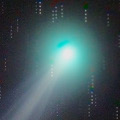
|
It approached to the sun down to 0.73 A.U. on Mar. 24, and brightened up to 4.7 mag (Mar. 11, Michael Mattiazzo). Now it is 5.2 mag (Apr. 7, Alexandre Amorim). In the Southern Hemisphere, it keeps locating low in the morning sky after this. It is not observable now in the Northern Hemisphere. But it becomes observable in May, and it keeps observable in good condition after that while fading gradually.
Date(TT) R.A. (2000) Decl. Delta r Elong. m1 Best Time(A, h)
Apr. 13 0 12.26 -6 53.0 1.634 0.827 24 5.4 4:02 (269,-13)
Apr. 20 0 13.76 -0 46.1 1.667 0.898 27 5.8 3:52 (266, -7)
|
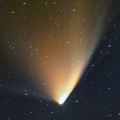
|
It passed the perihelion on Mar. 10, and brightened up to 0-1 mag. Now it is fading. But it is still bright as 5.2 mag (Apr. 7, Seiichi Yoshida). In the Northern Hemisphere, it will be getting higher gradually in the morning sky. It is not observable in the Southern Hemisphere for a while after this.
Date(TT) R.A. (2000) Decl. Delta r Elong. m1 Best Time(A, h)
Apr. 13 0 25.67 50 19.2 1.375 0.941 43 5.5 4:02 (221, 18)
Apr. 20 0 21.70 57 15.4 1.433 1.083 48 6.0 3:52 (216, 24)
|
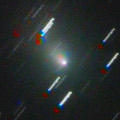
|
Now it is so bright as 10.8 mag (Mar. 29, Marco Goiato). In the Northern Hemisphere, it keeps observable in good condition until April. It locates low in the Southern Hemisphere.
Date(TT) R.A. (2000) Decl. Delta r Elong. m1 Best Time(A, h)
Apr. 13 4 19.97 16 59.7 2.124 1.553 43 12.0 19:58 ( 96, 21)
Apr. 20 4 34.44 14 17.7 2.163 1.533 39 12.0 20:06 ( 97, 15)
|
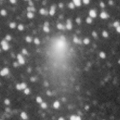
|
Now it is bright as 12.4 mag (Apr. 7, Carlos Labordena). It keeps observable at 11-13 mag for a long time from 2012 summer to 2013 summer.
Date(TT) R.A. (2000) Decl. Delta r Elong. m1 Best Time(A, h)
Apr. 13 15 0.00 1 16.9 1.965 2.902 154 12.6 1:37 ( 0, 56)
Apr. 20 14 45.48 4 50.9 1.996 2.955 158 12.7 0:55 ( 0, 60)
|

|
It brightened up to 11-12 mag in 2012. Now it is 12.3 mag (Mar. 23, Marco Goiato). It will be observable at 12-13 mag in good condition again in 2013.
Date(TT) R.A. (2000) Decl. Delta r Elong. m1 Best Time(A, h)
Apr. 13 14 36.21 -15 16.9 4.848 5.808 161 12.8 1:13 ( 0, 40)
Apr. 20 14 27.53 -14 47.4 4.839 5.832 170 12.8 0:37 ( 0, 40)
|
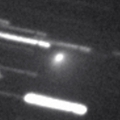
|
New bright comet. Now it is 12.5 mag and visible visually (Mar. 15, Alan Hale). It keeps locating in the morning sky for a long time after this. I will keep the current brightness for a long time.
Date(TT) R.A. (2000) Decl. Delta r Elong. m1 Best Time(A, h)
Apr. 13 22 18.60 3 54.6 2.000 1.501 46 12.8 4:02 (277, 16)
Apr. 20 22 38.19 5 13.0 2.013 1.537 48 12.9 3:52 (275, 17)
|

|
It brightened rapidly, and reached up to 12 mag in 2012. It is bright as 12.2 mag still now (Mar. 23, Marco Goiato). It keeps 12-14 mag until autumn. It locates somewhat low in the Northern Hemisphere.
Date(TT) R.A. (2000) Decl. Delta r Elong. m1 Best Time(A, h)
Apr. 13 19 35.87 -25 29.9 2.703 2.908 91 13.2 4:02 (329, 22)
Apr. 20 19 42.33 -25 51.9 2.616 2.913 96 13.2 3:52 (331, 23)
|
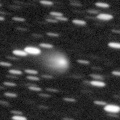
|
Now it is 14.1 mag (Apr. 3, Toshiyuki Takahashi). It keeps bright at 13-14 mag for a long time until 2014. It keeps observable for a long time in the Northern Hemisphere. It will be observable also in the Southern Hemisphere after April.
Date(TT) R.A. (2000) Decl. Delta r Elong. m1 Best Time(A, h)
Apr. 13 21 20.04 30 51.4 6.329 5.906 60 13.6 4:02 (257, 42)
Apr. 20 21 19.90 31 12.2 6.254 5.904 65 13.5 3:52 (259, 45)
|
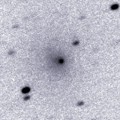
|
Now it is visible visually at 12.5 mag (Mar. 23, Marco Goiato).
Date(TT) R.A. (2000) Decl. Delta r Elong. m1 Best Time(A, h)
Apr. 13 13 57.42 -23 43.6 5.255 6.222 163 13.6 0:34 ( 0, 31)
Apr. 20 13 54.18 -23 30.1 5.235 6.221 167 13.5 0:03 ( 0, 31)
|
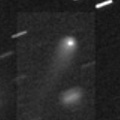
|
It keeps 13 mag and observable in good condition in the Northern Hemisphere for a long time from 2013 to 2014. Now it is 14.5 mag (Mar. 4, Sandor Szabo). It locates extremely low in the Southern Hemisphere.
Date(TT) R.A. (2000) Decl. Delta r Elong. m1 Best Time(A, h)
Apr. 13 9 24.15 49 41.2 3.844 4.161 101 14.1 19:58 (179, 75)
Apr. 20 9 16.64 49 59.1 3.925 4.126 94 14.1 20:06 (155, 73)
|
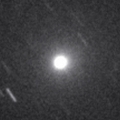
|
Now it is so bright as 11.8 mag (Mar. 9, Carlos Labordena). It will be fading gradually after this.
Date(TT) R.A. (2000) Decl. Delta r Elong. m1 Best Time(A, h)
Apr. 13 9 43.70 19 9.7 1.261 1.951 118 14.2 20:17 ( 0, 74)
Apr. 20 9 48.11 16 50.2 1.320 1.953 113 14.3 20:06 ( 9, 71)
|
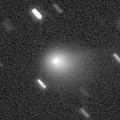
|
It brightened up to 9.0 mag in 2012 autumn (Nov. 4, Juan Jose Gonzalez). However, it faded out unexpectedly around the perihelion passage. It was expected to be 9-10 mag, but actually, it is much fainter as 13.9 mag (Mar. 20, Hidetaka Sato). In the Southern Hemisphere, it keeps observable in good condition while fading slowly after this. In the Northern Hemisphere, it is hardly observable after 2013.
Date(TT) R.A. (2000) Decl. Delta r Elong. m1 Best Time(A, h)
Apr. 13 23 50.09 -43 11.3 2.561 2.175 56 14.3 4:02 (306,-27)
Apr. 20 0 13.26 -43 7.4 2.567 2.222 58 14.4 3:52 (305,-28)
|

|
Big asteroid discovered in 1906. It suddenly showed the cometary activity on Dec. 11, 2010, probably due to an impact of a small object. It has already turned to be stellar. Appearing in the morning sky again in the Southern Hemisphere.
Date(TT) R.A. (2000) Decl. Delta r Elong. m1 Best Time(A, h)
Apr. 13 23 15.93 -17 17.8 3.466 2.794 41 14.6 4:02 (286, -8)
Apr. 20 23 26.46 -16 29.6 3.418 2.805 45 14.6 3:52 (286, -6)
|
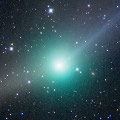
|
It kept as bright as 6-7 mag for a long time from 2011 summer to 2012 spring. Now it is fading. But it is bright as 15.2 mag still now (Mar. 4, Sandor Szabo).
Date(TT) R.A. (2000) Decl. Delta r Elong. m1 Best Time(A, h)
Apr. 13 8 9.56 -8 2.8 5.275 5.572 102 14.6 19:58 ( 26, 43)
Apr. 20 8 8.65 -7 46.1 5.443 5.633 95 14.8 20:06 ( 37, 40)
|
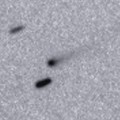
|
Now it is 15.5 mag (Apr. 3, P. Dupouy, J. Laborde, J. B. de Vanssay, G. Soulie). It keeps bright as 13-14 mag for a long time from 2013 to 2014. It is a bit fainter than this ephemeris recently.
Date(TT) R.A. (2000) Decl. Delta r Elong. m1 Best Time(A, h)
Apr. 13 14 41.18 -10 43.2 2.506 3.470 161 14.7 1:17 ( 0, 44)
Apr. 20 14 36.73 -10 32.3 2.465 3.456 168 14.7 0:46 ( 0, 44)
|
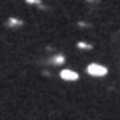
|
Now it is 14.9 mag (Mar. 4, Jakub Cerny). Already visible visually. It is expected to be a great comet in 2013 autumn when the comet approaches to the sun down to only 0.01 A.U. It keeps visible with naked eyes from November to January, and can be extremely bright as Venus or more at the highlight. It became unobservable in late May. The condition is excellent in the Northern Hemisphere. It will appear in the morning sky again in late August, then it keeps observable almost all through the period of brightening, at the highlight, and of fading. The condition is not good in the Southern Hemisphere. It is not observable at all the latter part of the highlight, and it keeps low all through the period.
Date(TT) R.A. (2000) Decl. Delta r Elong. m1 Best Time(A, h)
Apr. 13 6 37.40 30 8.2 4.256 4.115 75 14.8 19:58 ( 94, 55)
Apr. 20 6 38.45 29 52.4 4.287 4.031 68 14.7 20:06 ( 98, 48)
|
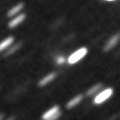
|
Now it is 14.9 mag (Mar. 30, Toshiyuki Takahashi). It will brighten up to 12 mag from summer to autumn. In the Northern Hemisphere, it will be unobservable in late April. In the Southern Hemisphere, it keeps unobservable until August. Then it keeps observable while fading gradually.
Date(TT) R.A. (2000) Decl. Delta r Elong. m1 Best Time(A, h)
Apr. 13 2 46.19 41 6.5 2.964 2.243 36 14.9 19:58 (129, 16)
Apr. 20 3 3.58 39 57.3 2.953 2.176 32 14.7 20:06 (130, 13)
|
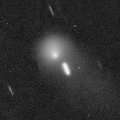
|
Now it is 14.7 mag (Feb. 3, Jakub Cerny). It will be fading slowly after this. But it keeps 15 mag in 2013. It is observable in good condition in the Southern Hemisphere. It is not observable now in the Northern Hemisphere.
Date(TT) R.A. (2000) Decl. Delta r Elong. m1 Best Time(A, h)
Apr. 13 3 19.13 -30 4.0 7.059 6.427 47 14.8 19:58 ( 65,-18)
Apr. 20 3 22.97 -29 6.9 7.108 6.453 46 14.9 20:06 ( 70,-23)
|
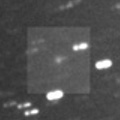
|
Now it is 15.2 mag (Mar. 30, J. F. Hernandez). It reaches up to 15 mag from spring to summer. It is observable in excellent condition in the Southern Hemisphere. It locates low in the Northern Hemisphere.
Date(TT) R.A. (2000) Decl. Delta r Elong. m1 Best Time(A, h)
Apr. 13 15 19.42 -46 35.3 2.586 3.372 135 15.0 1:56 ( 0, 8)
Apr. 20 14 59.15 -44 52.6 2.505 3.366 143 14.9 1:09 ( 0, 10)
|

|
It brightens up to 10 mag in summer. But the condition is worst and the comet will be hardly observable in this apparition. In the Northern Hemisphere, it will be observable in autumn when the comet will be fainter than 16 mag.
Date(TT) R.A. (2000) Decl. Delta r Elong. m1 Best Time(A, h)
Apr. 13 0 46.48 -2 47.9 2.480 1.536 15 15.8 4:02 (261,-18)
Apr. 20 1 6.10 -0 32.7 2.414 1.477 16 15.3 3:52 (258,-17)
|

|
It reached up to 12 mag from autumn to winter in 2012. Now it is not observable. But it will appear in the morning sky in July. Then it will be observable at 17 mag in good condition in autumn.
Date(TT) R.A. (2000) Decl. Delta r Elong. m1 Best Time(A, h)
Apr. 13 2 53.81 17 51.1 4.284 3.386 23 15.4 19:58 (109, 4)
Apr. 20 3 4.63 17 54.6 4.346 3.411 18 15.4 20:06 (112, -1)
|
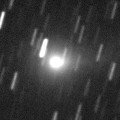
|
Long-lost comet for almost 200 years since 1827. Finally re-discovered by Rob Matson from SWAN images of mid November. Now it is fading, but still bright as 13.6 mag (Apr. 7, Seiichi Yoshida). In the Northern Hemisphere, it keeps observable in excellent condition while fading after this. In the Southern Hemisphere, it keeps locating extremely low after this.
Date(TT) R.A. (2000) Decl. Delta r Elong. m1 Best Time(A, h)
Apr. 13 13 36.31 54 45.8 1.405 2.056 116 15.4 0:15 (180, 70)
Apr. 20 12 48.84 53 27.7 1.534 2.146 113 16.0 22:50 (180, 72)
|
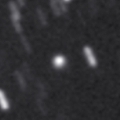
|
Now it is 16.1 mag (Mar. 18, Catalina Sky Survey). It is expected to brighten up to 5-6 mag in 2014 autumn. In 2013, it keeps observable in good condition until autumn when it brigthens up to 13-14 mag.
Date(TT) R.A. (2000) Decl. Delta r Elong. m1 Best Time(A, h)
Apr. 13 17 25.51 16 10.3 5.569 6.069 115 15.6 4:01 ( 0, 71)
Apr. 20 17 21.84 17 1.4 5.430 6.006 120 15.5 3:30 ( 0, 72)
|
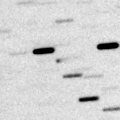
|
Now it is 16.6 mag (Apr. 2, Hidetaka Sato). It keeps observable at 16 mag in the morning sky from February to April.
Date(TT) R.A. (2000) Decl. Delta r Elong. m1 Best Time(A, h)
Apr. 13 20 45.50 -9 10.8 1.619 1.619 71 16.2 4:02 (304, 26)
Apr. 20 21 1.08 -8 11.3 1.591 1.643 74 16.4 3:52 (303, 27)
|
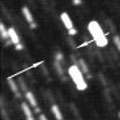
|
Now it is 16.1 mag (Mar. 4, Hidetaka Sato). In the Southern Hemisphere, it will be observable at 15-16 mag in good condition for a long time until summer. It is not observable at all in the Northern Hemisphere.
Date(TT) R.A. (2000) Decl. Delta r Elong. m1 Best Time(A, h)
Apr. 13 3 13.85 -51 33.4 4.727 4.396 64 16.3 19:58 ( 45,-28)
Apr. 20 3 25.39 -50 8.9 4.754 4.423 64 16.3 20:06 ( 48,-31)
|
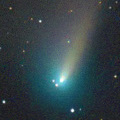
|
It approached to the earth down to 0.3 A.U. and brightened up to 7-8 mag from late December to early January. However, it will go away from the earth and fade out rapidly after this. It has already faded down to 15.3 mag (Mar. 3, Mitsunori Tsumura). It keeps observable in good condition in the Southern Hemisphere after this. It will never be observable again in the Northern Hemisphere.
Date(TT) R.A. (2000) Decl. Delta r Elong. m1 Best Time(A, h)
Apr. 13 4 48.86 -18 46.6 2.681 2.300 57 16.3 19:58 ( 63, 5)
Apr. 20 4 56.11 -19 12.6 2.811 2.379 54 16.6 20:06 ( 66, 0)
|

|
Now it is 16.8 mag (Mar. 31, Siding Spring Survey). It keeps 16 mag and observable in good condition until July.
Date(TT) R.A. (2000) Decl. Delta r Elong. m1 Best Time(A, h)
Apr. 13 19 33.98 -19 52.6 2.020 2.271 91 16.6 4:02 (326, 27)
Apr. 20 19 32.88 -16 29.6 1.896 2.259 97 16.4 3:52 (329, 32)
|
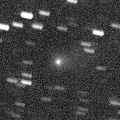
|
It brightened up to 15.5 mag in 2012 summer. Although it has already passed the perihelion, it tends to become brightest after the perihelion passage. It will be observabel at 16 mag again in 2013 summer. Appearing in the morning sky, but it has not been observed yet.
Date(TT) R.A. (2000) Decl. Delta r Elong. m1 Best Time(A, h)
Apr. 13 21 49.20 -18 49.0 3.829 3.440 60 16.5 4:02 (300, 8)
Apr. 20 21 56.86 -18 27.2 3.756 3.455 65 16.5 3:52 (301, 10)
|
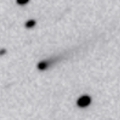
|
Now it is 15.9 mag (Mar. 15, P. C. Sherrod). It will be observable at 16-17 mag for a long time from 2013 to 2014.
Date(TT) R.A. (2000) Decl. Delta r Elong. m1 Best Time(A, h)
Apr. 13 11 54.63 6 35.7 2.950 3.867 152 16.5 22:27 ( 0, 62)
Apr. 20 11 51.86 6 37.8 2.994 3.862 145 16.5 21:57 ( 0, 62)
|
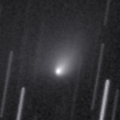
|
It brightened up to 13.7 mag and became visible visually in winter (Dec. 23, Juan Jose Gonzalez). Now it is fading. It has already faded down to 16.7 mag (Mar. 4, Toshiyuki Takahashi). It locates low in the Southern Hemisphere. It will be too low in the evening in late April also in the Northern Hemisphere.
Date(TT) R.A. (2000) Decl. Delta r Elong. m1 Best Time(A, h)
Apr. 13 4 51.66 21 41.0 3.081 2.573 51 16.5 19:58 ( 97, 30)
Apr. 20 4 59.66 20 7.5 3.207 2.611 45 16.7 20:06 ( 99, 23)
|
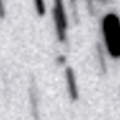
|
Now it is 17.3 mag (Mar. 21, P. Dupouy, J. Laborde, J. B. de Vanssay, G. Soulie). It is expected to brighten up to 14 mag in July and August. In the Southern Hemisphere, it keeps observable for a long time until the comet fades out. It keeps observable in good condition until September also in the Northern Hemisphere.
Date(TT) R.A. (2000) Decl. Delta r Elong. m1 Best Time(A, h)
Apr. 13 21 57.72 23 33.4 3.295 2.786 51 17.0 4:02 (261, 31)
Apr. 20 22 1.12 23 19.7 3.179 2.744 55 16.9 3:52 (263, 34)
|
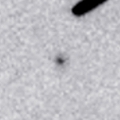
|
It is expected to brighten up to 11 mag and become observable in excellent condition in 2014 spring. Now it is 16.7 mag (Mar. 12, P. C. Sherrod). In the Northern Hemisphere, it keeps observable in good condition until early summer. It locates low in the Southern Hemisphere.
Date(TT) R.A. (2000) Decl. Delta r Elong. m1 Best Time(A, h)
Apr. 13 8 32.19 40 57.4 3.827 4.064 96 17.0 19:58 (123, 78)
Apr. 20 8 32.88 40 50.7 3.866 3.999 90 17.0 20:06 (115, 72)
|

|
Now it is 16.7 mag (Apr. 8, Siding Spring Survey). It will be fading after this. It locates low in the Northern Hempshere.
Date(TT) R.A. (2000) Decl. Delta r Elong. m1 Best Time(A, h)
Apr. 13 20 24.21 -37 9.1 2.482 2.576 83 17.1 4:02 (326, 7)
Apr. 20 20 19.32 -36 0.7 2.405 2.625 91 17.1 3:52 (329, 10)
|
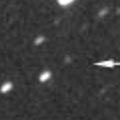
|
Now it is 18.3 mag (Apr. 11, Hidetaka Sato). It is expected to be observable at 16 mag in good condition in summer and autumn. But it is fainter than predicted recently.
Date(TT) R.A. (2000) Decl. Delta r Elong. m1 Best Time(A, h)
Apr. 13 21 44.25 4 8.7 2.580 2.167 55 17.1 4:02 (282, 23)
Apr. 20 21 57.65 5 38.5 2.516 2.158 57 17.1 3:52 (281, 25)
|
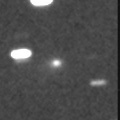
|
Now it is 16.5 mag (Mar. 12, P. C. Sherrod). It keeps observable in good condition at 17 mag until June. It locates somewhat low in the Southern Hemisphere.
Date(TT) R.A. (2000) Decl. Delta r Elong. m1 Best Time(A, h)
Apr. 13 9 10.25 21 56.2 1.387 1.974 110 17.2 19:58 ( 15, 76)
Apr. 20 9 17.99 21 28.3 1.444 1.965 105 17.2 20:06 ( 37, 74)
|
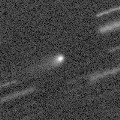
|
Now it is 17.3 mag (Mar. 16, Catalina Sky Survey). It brightened up to 16.5 mag in 2012. It will be observable in good condition again at 17.5 mag in 2013 spring.
Date(TT) R.A. (2000) Decl. Delta r Elong. m1 Best Time(A, h)
Apr. 13 13 9.60 8 28.1 5.141 6.103 162 17.4 23:41 ( 0, 63)
Apr. 20 13 1.73 8 55.7 5.190 6.122 156 17.4 23:06 ( 0, 64)
|

|
First return of a new periodic comet discovered in 2005. It will be observable at 17 mag for a long time from 2013 to 2014. However, it has not been recovered yet. Not it is fainter than 19.5 mag (Feb. 21, Martin Masek).
Date(TT) R.A. (2000) Decl. Delta r Elong. m1 Best Time(A, h)
Apr. 13 17 23.47 -14 0.9 2.669 3.307 121 17.5 3:59 ( 0, 41)
Apr. 20 17 23.80 -13 47.8 2.581 3.298 128 17.4 3:32 ( 0, 41)
|

|
It was observed around 20 mag in 2012 spring. But it has not been observed recently. It will be observable at 17.5 mag from spring to summer.
Date(TT) R.A. (2000) Decl. Delta r Elong. m1 Best Time(A, h)
Apr. 13 18 21.78 -21 31.5 2.141 2.629 107 17.6 4:02 (345, 32)
Apr. 20 18 25.75 -20 50.4 2.062 2.634 113 17.5 3:52 (348, 33)
|
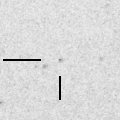
|
Now it is 17.5 mag (Mar. 16, Hidetaka Sato). It keeps observable in good condition at 17 mag from spring to summer.
Date(TT) R.A. (2000) Decl. Delta r Elong. m1 Best Time(A, h)
Apr. 13 18 41.04 -13 38.3 2.506 2.897 102 17.6 4:02 (337, 38)
Apr. 20 18 45.64 -12 46.6 2.421 2.898 108 17.5 3:52 (340, 40)
|
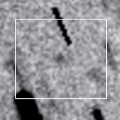
|
It was predicted to be already 16-17 mag. But actually, it is 19.8 mag, much fainter than predicted by 4 mag (Apr. 3, Jean-Francois Soulier). It was expected to brighten up to 14 mag and to be observable in excellent condition in summer. However, it can be fainter than 18 mag.
Date(TT) R.A. (2000) Decl. Delta r Elong. m1 Best Time(A, h)
Apr. 13 15 22.53 1 41.5 1.078 2.005 148 20.2 1:59 ( 0, 57)
Apr. 20 15 21.28 2 23.8 1.019 1.971 153 19.9 1:30 ( 0, 57)
|
|
![]()
 C/2012 J1 ( Catalina )
C/2012 J1 ( Catalina ) 273P/2012 V4 ( Pons-Gambart )
273P/2012 V4 ( Pons-Gambart ) C/2012 K1 ( PanSTARRS )
C/2012 K1 ( PanSTARRS ) 125P/Spacewatch
125P/Spacewatch C/2011 O1 ( LINEAR )
C/2011 O1 ( LINEAR ) C/2012 K5 ( LINEAR )
C/2012 K5 ( LINEAR ) C/2013 F3 ( McNaught )
C/2013 F3 ( McNaught ) 152P/Helin-Lawrence
152P/Helin-Lawrence P/2012 B1 ( PanSTARRS )
P/2012 B1 ( PanSTARRS ) C/2012 L1 ( LINEAR )
C/2012 L1 ( LINEAR ) C/2012 S3 ( PanSTARRS )
C/2012 S3 ( PanSTARRS ) C/2012 X1 ( LINEAR )
C/2012 X1 ( LINEAR ) C/2013 G2 ( McNaught )
C/2013 G2 ( McNaught ) 257P/2012 F4 ( Catalina )
257P/2012 F4 ( Catalina ) 175P/Hergenrother
175P/Hergenrother C/2010 R1 ( LINEAR )
C/2010 R1 ( LINEAR ) P/2005 L1 ( McNaught )
P/2005 L1 ( McNaught ) 91P/Russell 3
91P/Russell 3 P/2012 F2 ( PanSTARRS )
P/2012 F2 ( PanSTARRS ) 98P/Takamizawa
98P/Takamizawa![]()


































